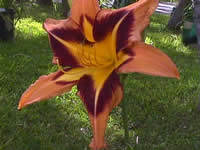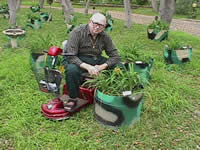Search
For The Answer
Click here to access our database of
Plant Answers
Search
For The Picture
Click here to access the Google database of plants
and insects
Milberger's Nursery and Landscaping
3920 North Loop 1604 E.
San Antonio, TX 78247
210.497.3760
nursery@milbergersa.com

Three exits east of 281, inside of 1604
Next to the Diamond Shamrock station
Please click map for more detailed map and driving directions.



Return
to Gardening Columns Main Index
|
DAYLILIES Texans are discovering the beauty of perennials.
Bursting back onto the scene with particular zest are daylilies,
a diverse group of perennial flowers unsurpassed for versatility
in the home landscape. Anyone who associates the daylily exclusively with orange or yellow star-shaped blooms might wonder what all the excitement is about. The news is that this old-fashioned flower has a contemporary new look. Blossoms now come in pink, purple, red, peach, apricot and all shades in between, including dramatic color combinations. Petals may be ruffled, twirled or flecked with eye-catching glitter called "diamond dust." And there are lots of new sizes and shapes, ranging from giant spidery blooms a full 12 inches wide to biscuit-shaped miniatures barely 2 inches across. Daylily plants may rise to a height of 4 feet or remain as short as 12 inches. The taller varieties make wonderful additions to traditional perennial borders, while low-growing types perform beautifully as ground covers. Daylilies can also be planted in naturalistic drifts in lawns, where they will multiply and spread like wildflowers. The scientific name for daylily is Hemerocallis, meaning "beauty for a day." Although individual blooms are short-lived, opening and fading the very same day, individual plants continue to blossom for weeks. Flower stalks of modern cultivars carry an average of 20 to 30 buds. On a given day anywhere from 1 to 6 buds may unfurl. As one flower stalk becomes depleted, another takes its place either immediately or a few weeks later. With the advent of early, mid-season and late-blooming varieties, gardeners now can have continuous color from spring into autumn. Daylilies flourish with little care in almost every part of the country. The old rule of thumb was that evergreen varieties do best in the South and dormant varieties do best in the North. But nowadays the vast majority of modern evergreens and dormants do well everywhere. Evergreen daylilies retain their foliage throughout the year, while the tops of dormant varieties die to the ground each autumn. The tuber-like roots can be planted in spring or fall, preferably in spots receiving at least 6 hours of direct sunlight daily. Daylilies are not finicky about soil, although a well-drained loam is best. If soil is heavy, mix in some peat moss or compost at planting time. While it is best to plant the roots immediately upon arrival, they can be stored out of sun in a cool dry area or in damp sand for a week or 2. They should not be left in standing water for a period in excess of several hours. Daylilies should not be planted too deep! Instead of digging a hole, loosen the soil to a depth of 1 foot and then fashion a cone barely below ground level. After spreading the roots over the cone, cover them with about 1-1/2 inches of soil and water thoroughly. Spacing varies according to use in the landscape. Whenever doing any mass planting, say with 25 or more daylilies per bed, space the roots 12 to 15 inches apart. But if you want a colorful garden accent, plant in groups of 3 or 5, leaving just 6 inches between individuals. Don't fertilize newly planted daylilies for at least 4 to 6 weeks. Established plants should be fed with a low-nitrogen fertilizer (use half the amount recommended on the label) and only in the early spring and again in fall, when temperatures are cool. New plantings should be kept moist for the first month. Although established daylilies are drought-resistant, they perform best if watered whenever soil becomes dry. Beyond this, little ongoing care is required. Every 3 to 5 years, daylilies become root bound and should be divided. Simply dig up any overgrown clumps in spring or fall, shake off the loose dirt and then separate each clump by hand or with a knife into a few individual plants. The divisions can be replanted or given away to friends. The roots are extremely hardy and do not have to be dug and stored for winter, even in the coldest climates. THE HARDY DAYLILY MAKES NICE BORDER Many colors of daylilies are available except white and blue. The original plants from Asia had only yellow and orange blooms. During recent years, plant breeders have used a red-flowered species from China to develop pink, red and dark purple varieties. The daylily may be the answer if you are looking for a hardy perennial for your flower border. These plants will survive almost any abuse and still bloom. You will also have very little trouble with disease or insect pests. They produce an abundant display of flowers and the coarse, grass-like foliage retains its attractive green color during the entire growing season. Daylilies love sun but will grow and bloom in partial shade if they receive 6 hours of sun each day. This vigorous plant can also compete with the roots of trees and still make satisfactory growth. The earliest flowering daylilies bloom in April with the iris. A careful selection of varieties will provide continuous blooming through August and early September. Some varieties will produce flowers in the spring and a second crop later in the summer. Be sure to remove spent flowers to prevent seed formation. This will prolong the flowering season and will prevent seedlings. As with many of our garden flowers, we now have dwarf daylilies. Compared to standard varieties with flowers about 3 feet tall, the dwarf types are about 18 inches high. They are useful in the border in front of taller plants, as a ground cover on a bank, or for naturalizing where the standard varieties would be too large. Daylilies produce an abundance of blooms which provide beauty in the landscape. They may be used as cut flowers but each bloom lasts for only one day. Other buds in the cluster will open on succeeding days if the flowers are used in a loose bouquet. The culture of daylilies is relatively simple. They will grow for many years with a minimum of care. If each plant is to become a large, separate specimen, clump space them about three feet apart. If a solid mass planting is desired for a border, or as a ground cover, place them about one foot apart. Daylilies are propagated by dividing the large clumps into small sections. The best time to divide clumps or establish a planting is in the fall a few weeks before the first frost. They may also be divided and set in the spring about a month before the average date of the last frost. However, this tough plant may be dug up and reset almost anytime. Daylilies should not be planted too deep! Instead of digging a hole, loosen the soil to a depth of 1 foot and then fashion a cone barely below ground level. After spreading the roots over the cone, cover them with about 1-1/2 inches of soil and water thoroughly. Daylilies require only moderate amounts of fertilizer, and their heavy growth of leaves serves as a mulch once they are well established. Local daylily experts have compiled a list of
the some of the best varieties for this area. For an updated
list of recommended varieties, check the Website at: NOW is the time to plant one of the easiest to grow perennials. Don't miss the beauty of this spectacular bloom. The Intimate Garden With Daylilies When I retired from the United States Air Force
I was 55 years old. With the The devastating drought of 2000 hit south Texas.
A dome of high pressure hung over us day after day and the
temperature rose as high as 111 degrees. The Edward's Aquifer
shrank rapidly. This is the only source of potable water for
San Antonio and surrounding area. Many watering restrictions
were imposed by the various agencies and authorities. The
price of water went up which was also a deterrent. My August
water bill was $1300 dollars and that was comparatively low.
It was obvious that large St. Augustine lawns were no Y2K, remember Y2K? This was an exercise in preparedness which is something that we should think about more than we do. "Be prepared" is the Boy Scouts' solemn creed. I had some barrels in which we stored Y2K water. Since these were excess to our immediate need, we sawed these plastic 55 gallon syrup barrels in half, drilled drainage holes in the bottoms, connected all half barrels to one water source with a check valve and PVC pipe, filled them with dirt, and planted 200 daylilies. The plant containers (barrels) were randomly placed in an oval drive way island roughly 50 X 100 feet. Each plant container with drainage holes drilled in the bottom also had a ½ inch hole drilled next to the container inside wall for a vertically installed water supply pipe. Using tees, elbows clamps, hose and flow hose each container was outfitted with it's own watering system. Each container was then attached to a continuous buried loop ½ inch water supply PVC pipe which intern is supplied with water from a single standpipe with check valve and a pressure gage. I want to talk just a bit about the check valve. Texas law mandates that any time you hook up to a potable water source a check valve must be installed. There are times when it is possible for, in this case, water to siphon from the plant container in to the water supply system and end up in your iced tea. It is a delight to operate the watering requirements of the containers. As we are primarily caring for daylilies all containers are watered at the same rate. This could be modified using resistors so some get more water than others. The water is turned on at low pressure, 10 pound per square inch PSI and turned off when the water requirements have been met. A water wand takes the guess work out of when to water and should always be used. One item that we were concerned with was internal temperature of the barrel soil. On the day, in San Antonio, that it was 111 degrees the barrel temperature at daylily root depth was 92 - within normal limits, at least for this part of the world. Each container was filled with ROSE MIX from Gardenville. First we placed some locally available rocks in the bottom of the containers to reduce the amount of soil needed to fill the containers. The rose mix is wonderful. Sand, some clay, compost and finally ground cedar (juniper) it stays soft and pliable and easy to plant, by hand. Martha Montgomery, a charter member of the San Antonio Daylily Society would call it "sugar and cream dirt". So far this mix is holding moisture well, with out being soggy. Many of the daylily growers discard their soil in seedling beds annually. This would be easy to do with the barrels. The best part is that the some eighty plants planted in late August are all surviving with no crown rot or any other problems and this with the fact that they were shipped during the hottest time in our history, and looked it on arrival. On a personnel note, those of you familiar with our garden may remember that our original layout included circular plots the were some 25 feet in diameter. As time went by and I got older the newer beds were designed to be no more than 6 feet wide. This allowed me to sit on the edge and reach in 3 feet on the side for weeding, grooming etc. Now I have difficulty walking and this is certainly true on uneven ground. Walla! I drive my trusty scooter up to any one of my new forty nine gardens and have a ball. It is now a year later, this spring we had rain and clouds, for seven weeks, as a result the peak bloom period was also late and not as gratifying as in past years, except those growing in the barrels. They bloomed, re-bloomed, set record numbers of buds and all in all were a delight.
Years ago my wife and I were visiting the Melon Art Gallery in Washington. As we went from one exhibit to another we noticed an attractive young woman in a wheel chair looking at the various exhibits. As we were leaving the museum this young woman rolled up to the front desk, stood up, and said to the attendant "thank you very much" and walked out. We commented at the time, "What a way to study paintings." Well, what a way to garden! I can hardly wait to get out among and between my barrels every day, rain or shine. I started out with this barrel project to save water and money. Enough so that I could continue to grow a thousand or so cultivars. As the first two hundred daylilies, planted in the barrels, began to flourish and bloom this last April - June the project became more than a water conservation exercise. I recognized the value this garden concept could be for the handicapped. It is exciting to know that for not much money, twenty five dollars or less, anyone in a wheel chair or a scooter could have a garden. A two barrel kitchen or flower garden and also to know that this concept could be expanded. Ours is under construction for a programmed total of two hundred barrels. Then a few weeks ago, as I was scooting about
the garden, it hit me, this concept of gardening should and
could be for any gardener, particularly a new daylily gardener.
There are many thesis on container gardening but I have not
seen any that takes advantage of the plastic barrel available
anyplace Coca-Cola or other soft drink syrup is shipped and
our application as outlined herein. I have experienced an
intimacy with my plants that I have never had before. This
relationship began with close observation and inspection of
each plant, ever day then, I realized I was more than inspection,
it was the pure pleasure of visiting and knowing old friends
on such an intimate basis. So! There you have it. The philosophy of the intimate garden using daylilies. And then time went bye. The balmy days of December
2001, January & February 2002. The daylilies loved this
weather particularly the evergreens and obligingly put on
luxurious new growth. Until the last days in Feb. and whamo,
the temperature drooped to 17 degrees F. on the 28th and stayed
below freezing for 10 hours. Each of the barrels is supplied
with a built in irritations system piped in from a single
source of water. I ran this system all night and subsequent
nights that it froze. The barrel plants suffered some freeze
back but not nearly so much as the daylilies in the our conventional
gardens. 14 March 2002 |




